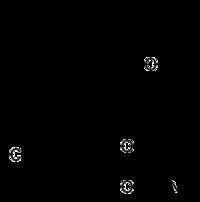Formula C23H19ClF3NO3 | Molar mass 449.85 g/mol | |
 | ||
Appearance Dark brown/green solid. Colorless when pure | ||
Cyhalothrin is an organic compound that is used as a pesticide. It is a pyrethroid, a class of man-made insecticides that mimic the structure and insecticidal properties of the naturally occurring insecticide pyrethrum which comes from the flowers of chrysanthemums. Synthetic pyrethroids, like lambda-cyhalothrin, are often preferred as an active ingredient in insecticides because they remain effective for longer periods of time. It is a colorless solid, although samples can appear beige, with a mild odor. It has a low water solubility and is nonvolatile. It is used to control insects in cotton crops.
Contents
Structure
Lambda-cyhalothrin is a mixture of isomers of cyhalothrin. Brand names include "Danger" by "OPAL Agrochemical Pakistan" 'Karate', 'Kung-fu', 'Matador', 'Cyzmic CS', and 'Demand CS' (Syngenta); Proaxis in Indonesia by PT Dow AgroSciences Indonesia; in the USA, 'Triazicide' and 'Hot Shot' are used in the home landscape and garden markets Home Depot carries a brand of the Lambda-cyhalothrin insecticide under the brand name Real Kill and Spectracide Bug Off. Terro also makes an outdoor ant and other insect prevention treatment similar to Home Defense using this ingredient. Syngenta held the patent for Lambda-cyhalothrin. This patent expired in most major markets in 2003. Lambda cyhalothrin may be marketed as Charge, Demand CS, Excaliber, Grenade, Hallmark, Icon, Karate, Matador, OMS 0321, PP321, Saber, Samurai, and Sentinel.
Gamma-cyhalothrin is a single stereoisomer of the pyrethroid insecticide cyhalothrin, and as such shares physical, chemical, and biological properties with both cyhalothrin and lambda-cyhalothrin, which are mixtures of 4 and 2 isomers respectively. Gamma-cyhalothrin is the most insecticidally active isomer of cyhalothrin/lambda-cyhalothrin, and thus the technical gamma-cyhalothrin product may be considered a refined form of cyhalothrin/lambda-cyhalothrin in that it has been purified by removal of less active and inactive isomers. Thus, similar levels of insecticidal efficacy for gamma-cyhalothrin can be obtained with significantly reduced application rates as compared with either cyhalothrin or lambda-cyhalothrin. The tolerance under 40 CFR 180.438 currently identifies lambda-cyhalothrin as a 1:1 mixture of two isomers and their epimers, one of which is the gamma isomer. The gamma isomer is present at 42% in this mixture. By contrast in the proposed tolerance expression the gamma isomer is present at 98% in the mixture. Home Depot carries a brand of the Gamma-cyhalothrin insecticide under the brand name Spectracide Triazacide.
Mechanism of action
Pyrethroids, including lambda-cyhalothrin, disrupt the functioning of the nervous system in an organism. By disrupting the nervous system of insects, lambdacyhalothrin may cause paralysis or death. Temperature influences its effectiveness. It is highly toxic to many fish and aquatic invertebrate species. Bioconcentration is possible in aquatic species, but bioaccumulation is not likely. Binding of lambda-cyhalothrin to soil and sediment reduces exposure and may lessen the risk to fish. Field studies found no significant adverse effects to fish. Lambda-cyhalothrin is also highly toxic to bees, although again field studies found few effects. In laboratory studies, alkaline water degraded lambda-cyhalothrin with an approximate half-life of 7 days, although at neutral and acidic pH's degradation did not occur. Sunlight accelerates degradation in water and soil. The half-life of lambda-cyhalothrin on plant surfaces is 5 days. Lambda-cyhalothrin has a low potential to contaminate ground water due to its low water solubility and high potential to bind to soil.
Regulation
The LD50 is 79–56 mg/kg (rats, oral). It decomposes in extreme heat (257 °C), liberating toxic gases like CO and HCN. It is a potent irritant to mucous membranes and is highly toxic in concentrations higher than 97%.
